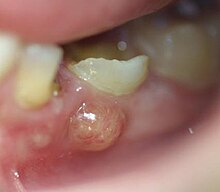Tricho-dento-osseous syndrome
| Classification according to ICD-10 | |
|---|---|
| Q82.4 | Other congenital malformations of the skin
- Ectodermal dysplasia |
| ICD-10 online (WHO version 2019) | |
The Trichoderma-dento-osseous syndrome is a very rare congenital disease with the main features of abnormalities of hair (funnel-) and teeth (Dent) combined with osteosclerosis (osseous). It is considered a special form of ectodermal dysplasia .
Synonyms are: hair-tooth-bone syndrome; TDO syndrome; taurodentism, kinky hair syndrome; Robinson Miller Worth Syndrome
The name refers to the first author of the first description from 1966 by the Canadian pediatrician Geoffrey Robinson and colleagues.
The Robinson-Miller-Bensimon syndrome should not be confused .
distribution
The frequency is given as less than 1 in 1,000,000, and more than 30 patients have been reported to date. The inheritance is autosomal dominant , first proven by.
root cause
The disease are mutations in DLX3 - gene on chromosome 17 locus q21.33 based encoding gene Homebox-3 for the Distal-less.
Clinical manifestations
Clinical criteria are:
- curly / kinked hair at birth in up to 80%, sometimes normalizing later, "kinky hair"
- Enamel hypoplasia with discoloration,
- Taurodontics of the molars
- Generally increased bone mineral density, especially in the ulna and radius , with increasing age also in the spine
- thickened skull roof.
The following were also described: brittle fingernails, tendency to caries and abscesses , later tooth eruption, dolichocephaly , lack of pneumatization of the paranasal sinuses .

Classification
According to the clinical findings, three types are distinguished:
- Type I with hair anomalies in childhood, tooth anomalies with tooth loss in the 2nd – 3rd Decade of life, nail anomalies, facial dysplasia with dolichocephaly, premature suture synostosis with balcony forehead; Facial asymmetry and osteosclerosis of the skull bones and base of the skull
- Type II with hair abnormalities from birth, tooth abnormalities, nail abnormalities, facial dysplasia with prognathy ; prominent forehead, osteosclerosis of the skull bones and long tubular bones, narrowed external auditory canals in the male sex
- Type III with hair anomalies, tooth anomalies, nail anomalies, facial dysplasias with a prominent forehead, square chin, osteosclerosis of the skull, macrocephaly
diagnosis
The diagnosis is based on clinical and radiological findings and can be confirmed by detecting the mutation.
Differential diagnosis
The following must be distinguished from the differential diagnosis:
- Type AIHHT of amelogenesis imperfecta
- ODDD syndrome (Okulo-dento-digital dysplasia)
- autosomal dominant form of osteopetrosis .
therapy
Treatment is symptomatic with regular dental checks.
Prospect of healing
The prognosis is considered to be favorable without an increased tendency to fracture.
literature
- P. Jain, R. Kaul, S. Saha, S. Sarkar: Tricho-dento-osseous syndrome and precocious eruption. In: Journal of Clinical and Experimental Dentistry. Volume 9, number 3, March 2017, pp. E494 – e497, doi: 10.4317 / jced.53348 , PMID 28298997 , PMC 5347304 (free full text).
- OB Al-Batayneh: Tricho-dento-osseous syndrome: diagnosis and dental management. In: International journal of dentistry. Volume 2012, 2012, p. 514692, doi: 10.1155 / 2012/514692 , PMID 22969805 , PMC 3434396 (free full text).
- M. Islam, AG Lurie, E. Reichenberger: Clinical features of tricho-dento-osseous syndrome and presentation of three new cases: an addition to clinical heterogeneity. In: Oral surgery, oral medicine, oral pathology, oral radiology, and endodontics. Volume 100, Number 6, December 2005, pp. 736-742, doi: 10.1016 / j.tripleo.2005.04.017 , PMID 16301156 .
Individual evidence
- ↑ a b c Bernfried Leiber (founder): The clinical syndromes. Syndromes, sequences and symptom complexes . Ed .: G. Burg, J. Kunze, D. Pongratz, PG Scheurlen, A. Schinzel, J. Spranger. 7., completely reworked. Edition. tape 2 : symptoms . Urban & Schwarzenberg, Munich et al. 1990, ISBN 3-541-01727-9 .
- ↑ a b c d Tricho-dento-osseous syndrome. In: Orphanet (Rare Disease Database).
- ^ GC Robinson, JR Miller: Hereditary enamel hypoplasia: its association with characteristic hair structure. In: Pediatrics. Volume 37, Number 3, March 1966, pp. 498-502, PMID 5906373 .
- ↑ J. Lichtenstein, R. Warson, R. Jorgenson, JP Dorst, VA McKusick: The tricho-dento-osseous (TDO) syndrome. In: American Journal of Human Genetics . Volume 24, Number 5, September 1972, pp. 569-582, PMID 5054226 , PMC 1762186 (free full text).
- ↑ Trichodontoosseous syndrome. In: Online Mendelian Inheritance in Man . (English)
- ^ Altmeyer's encyclopedia